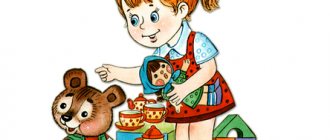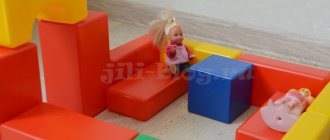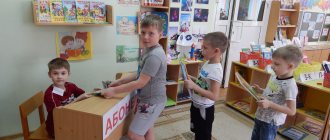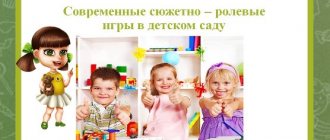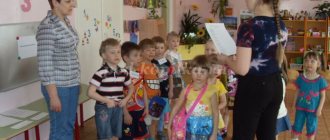Games for any child are the main source of information about the world around them: they prepare them for adulthood and help them adapt to new living conditions. Role-playing games in the senior group of a preschool institution help to learn the rules of behavior, teach how to behave in various situations, and strengthen the child’s psyche.
The child develops a character and an idea of morality based on the social and public experience he has gained. Role-playing activities are an opportunity for a preschooler to “try on” the life of adults, where he so strives to get. Activity demonstrated in this way allows you to feel your inner freedom, independence, and interact with others on equal terms.
The meaning of story games
The development of a little person is impossible without a variety of games. At an early age, it is enough for the baby to take a rattle in his hands and shake it. Children grow up, they are attracted to new toys, and the rules of the game become more complex. The baby strives to involve those around him in the gameplay, first his mother, then other children. The creativity in the personality of a preschooler is manifested.
A plot appears in the gaming activity: the children begin to assign playing roles and agree on the rules. Thematic role-playing games of preschoolers in the older group are already becoming more specific on the topic: not just “play with dolls,” but depict a plot scene, for example, a tea party with guests, where each child has a specific role, or act out a scene of disobedience. The child creates an imaginary situation that allows him to try on any role and feel like the main character.
The preschooler is absolutely independent in his actions: he can cut off bread with an imaginary knife, or with a small stick, imagining it as a key, open the lock on the door. The kid imagines himself in the hospital, at school, in the store, acting out various situations. The child’s self-expression manifests itself especially clearly in story-based play situations.
Experts identify role-playing games as a separate creative type, which are characterized by the mandatory presence of a plot, distribution of roles, and are subject to certain game rules. Any game process with a plot and distributed roles is a gaming activity of a team. Several people are involved here.
Significant socialization occurs precisely in joint activities, when preschoolers interact with each other in accordance with accepted roles. The baby learns the norms of social and moral behavior, and develops communication skills. The fidget learns to show independence, find a way out of complicated situations, and engage in constructive communication during conflicts. The child gains experience of behavior in different situations.
Among the characteristic features of all role-playing games of older preschoolers, many experts attribute the duality of the nature of the game process, which manifests itself in the combination of the fictional, imaginary world of adults with the reality of the actions of preschoolers in the game. For example, a baby is sitting on a chair, and at the same time in game reality this child is a bus driver.
Game objects replace in the imaginary world objects that are inherent in the world of adults. The duality of the situation allows preschoolers to receive information and acquire knowledge about aspects of reality previously unknown to them. The kid cannot cure a sick person or pull out a tooth, but in the gameplay he learns what a doctor does, how to behave in a hospital, and that helping people is good.
Subject development environment in preschool institutions
In the 1990s, in the works of V.A. Petrovsky, L.M. Klarina, L.A. Smyvina, L.P. Strelkova, N.Yu. Kuznetsova, V.V. Mikhailenko, N.A. Korotkova, E.I. Rzayeva and other scientists raised the question of a subject-development environment. The term "development environment" has become very popular for quite some time. However, the term "environment" does not have a clear definition in science. The term "development environment" can be considered in a broad and narrow sense.
In the broadest sense, a developing educational environment is a sociocultural space in which the process of personal development occurs spontaneously or with varying degrees of organization. From the point of view of psychologists such as L.S. Vygotsky, P.Ya. Galperin, V.V. Davydov, L.V. Zankov, A.N. Leontyev, D.B. Elkonin, a developmental environment is a certain ordered educational space in which developmental learning takes place. Most experts use the concept of Doctor of Psychological Sciences S.L. Novoselova: “A developing subject environment is a system of material objects of a child’s activity, which functionally modernizes the content of the development of his mental and physical figure. An enriched developmental environment presupposes the unity of social and natural means of ensuring a child’s varied activities.”
Meanwhile, in domestic preschool pedagogy and psychology, extensive experience has been accumulated in working on the problem of upbringing and teaching preschool children through play activities (L.S. Vygotsky, D.B. Elkonin, A.V. Zaporozhets, S.A. Novoselova, E.V. Zvorygina, N.Ya. Mikhailenko, N.A. Korotkova, N.V. Nishcheva, etc.) A feature of these studies is the emphasis on building an object-based play environment, which involves the search for new approaches to organization in a preschool institution, work in a new environment - within the framework of a person-oriented approach. In a preschool educational institution, it is possible to organize such an environment aimed at “harmonizing the quantity, diversity, originality, variability, degree of influence on the child’s personality” (R.B. Sterkina) of all its components, which contributes to the development of the preschooler’s personality, becomes a source of his knowledge and social experience , including gaming.
It can be seen that an important task of modern preschool education is to improve the pedagogical process and improve the quality of work with children through the proper organization of the play environment, where the child can show his own activity and fully realize himself. The subject-development environment created in the group provides high-quality preschool education, ensuring the protection and strengthening of the physical and mental health of pupils, promoting high moral development and upbringing of children.
In accordance with the recommendations of federal state educational standards, educational work with children is carried out in the process of organizing various types of children's activities: games, communication, labor, cognitive and research activities, productive activities, musical and artistic activities, which helps to meet the needs of children.
The thematic building environment of the senior group should be based on the following principles:
- Informative, providing a variety of topics for children's activities, materials and equipment used by children in the process of activity;
- Variability due to the content of regional education, national, cultural and artistic traditions of the region;
- Multifunctionality, which provides not only options for the different use of certain components of the subject-development environment depending on the subject of the activity, but also consistent lines between all components of the educational process;
- Expediency, providing the subject-developmental environment of the group with the necessary and sufficient content, which gives children opportunities for self-expression, contributes to the individual well-being and emotional well-being of each child;
- Transformability, which implies the possibility of changing the subject-development environment depending on the types of activities being solved and educational tasks.
The role of the teacher in organizing the game process
Often adults believe that it is not worth organizing children's leisure time; it is enough to give dolls, cars, puzzles, construction sets and give complete independence to the child. Do not forget that the game process contributes to the full development and upbringing of children.
Left to their own devices, unorganized leisure of preschool children will not carry any cognitive information. The opposite situation is also possible, when children left without adult supervision can insult each other and start fights during play activities.
Most preschoolers are conservative by nature - they prefer to play and act out those storylines in which they are familiar with all the rules and conditions. If preschool children are given the task of independently choosing what to play, then most likely it will be “mothers and daughters”, “hospital”, “shop” or war games with catch-up, which boys usually prefer.
Constantly repeated stories do not contribute to broadening one’s horizons and acquiring new skills and knowledge. Sometimes children begin to develop aversion to any changes. A proposal to change or supplement the plot causes a sharply negative reaction. A child who proposes something new is not accepted into the team and begins to be ignored.
The inability to change the plot, act out a new scene, or endlessly repeat the same actions is a consequence of the inability to use imagination and lack of knowledge. Very early in any children's group a leader appears, recognized by the rest of the kids. He quickly organizes gaming activities, distributes who will portray whom, and sets the rules.
The strict rules dictated by such a leader do not allow other children to express themselves and limit their development as independent individuals. It is the educator, teacher or parents who must take a leading, guiding role in organizing play time. Adults, in order to broaden the horizons of preschoolers, organize new role-playing games, monitor the development of the plot, and unobtrusively help in the gameplay.
You can’t just offer a game to play: for preschoolers, the process of preparation, discussion of the storyline, distribution of roles, and adherence to the rules discussed in advance are important. It is necessary to give every preschooler the opportunity to fantasize, to offer his own version of the plot development, so that the kids develop a desire to invent and create.
Any story-based game requires the presence of game attributes: for a hospital you will need white coats and caps, for a store - scales, a cash register. Adults can help organize gaming activities, while slightly complicating the game rules and adding new conditions. For example, when playing “mothers and daughters,” you can play around the arrival of another child in the family.
At home, parents can also arrange joint story games with their child: play at the hospital, at school, at a cafe. Adults have a decisive influence on children, their behavior, adherence to moral standards, ability to negotiate and communicate.
"Family"
One of the most popular is the role-playing game “family” for children in the older group. Every child often imagines himself in the place of his mother or father. The preschooler likes to act out various family scenes, often changing roles.
Target:
- reproduce the everyday life of a family, learn to create your own environment for a given plot using toys and other things;
- developing a sense of the value of family relationships, mutual assistance, love;
- involvement in work activities around the house through gameplay;
- create an understanding of what a family budget and joint housekeeping are.
Preparation:
- invite preschoolers to remember how holidays are celebrated at home, for example, the birthday of a family member;
- discuss what the parents are doing at home, how the family spends their free time, how they clean the house, prepare food, and welcome guests;
- choose a topic.
- Each child must be assigned an independent role in the game plot.
Items: dolls, toy furniture and dishes, car, apron, scarf. A variety of items that will be needed in the process.
Plot. Grandma's birthday. We are waiting for guests. Spring-cleaning. My daughter is capricious. A car ride into nature. The child got sick.
Actions. For example, when choosing a “Birthday” plot, many characters will be required. Some kids are preparing a holiday dinner, others are buying gifts. It is necessary to set the table beautifully, put the house in order, and prepare ceremonial congratulations. Adults observe how family members communicate, how they help each other, and suggest correct behavior to preschoolers.
Elements of labor activity are also introduced into the process: it is necessary to wash and iron clothes, repair a TV or iron. For realism, they act out everyday scenes: a pipe burst, a light bulb burned out, planning a joint budget.
"In the cafe"
Preschoolers should already know the rules of behavior in public places. A role-playing game “in a cafe” will help kids understand how to behave correctly in public places.
The goal is to become familiar with public places, the work and responsibilities of a waiter, cook, and cafe director, and to develop a culture of behavior.
Items: furniture, cafe dishes, dolls, aprons for waiters, chef's hat, money, bank cards.
Plot: after a walk, go to a cafe with friends.
Actions: children enter the cafe, take tables, and place an order. Waiters bring orders and serve customers. The children thank the waiter and cook for their work and pay.
Preschoolers can change roles: those who were clients will next time become waiters and treat guests of the cafe. During the gameplay, kids must understand that it is not nice to shout loudly, wave their arms, or run between tables. Fidgets must learn to behave well.
"Library"
Currently, few children know about the work of librarians or about why libraries themselves are needed. Preschoolers get used to using a computer from early childhood, without paying attention to books. The plot-role-playing game “library” for preschoolers in the older group reveals the importance and value of books.
The goal is to develop a caring attitude towards literature and books, increase vocabulary, broaden horizons. Give an idea of the work of a librarian, instilling respect for the profession. Learn to find the book you need in the library and be able to use the catalogue.
Items: bookshelves, tables, books, coloring books, sets of postcards.
Preparation and plot. Preschoolers remember what a library is, who works there, what they do, how can they borrow a book from the library? Several kids are selected to play the role of librarians, the rest are readers and library visitors.
Actions. Each librarian has several books and magazines. Readers come up and ask to see books. When the child has chosen a book, the librarian asks why the reader chose this particular book? Registration of the reader's form. The librarian gives books to real lovers of reading, and to prove this, the little reader recites a poem.
The librarian offers to look at magazines and sets of postcards in the reading room. After completing the game, preschoolers share their opinions on which books they saw and which they liked. Evaluate the work of librarians.
"Polyclinic"
Unfortunately, all children encounter diseases in their lives, and as a result, doctors. The role-playing game “clinic” introduces fidgets to the work of doctors.
The goal is to introduce preschoolers to the medical profession, to cultivate a sense of compassion and kindness towards the sick. Kids learn to be attentive and sensitive.
Items: toy sets for doctors, white coats and caps, disposable masks, shoe covers. Thermometer, syringes for injections, bandages, scissors. Recipe paper.
Preparation, plot. The actions of different doctors are chosen for the plot. For example, an appointment with a pediatrician, dentist, or ophthalmologist. Variations of the plot include: taking tests, conducting vaccinations.
Before offering such a plot, the teacher carries out preliminary preparation. He talks about the work of different doctors, can organize a visit to the clinic or invite a medical worker to the group. Preschool children are divided into doctors and a group of patients. Some may take on the role of a nurse.
Actions. The patient comes to the clinic, puts on shoe covers, takes a card from the reception desk and a referral to see a doctor. The doctor examines the patient. He asks what complaints there are and listens carefully. Checks blood pressure, examines throat and ears. Prescribes a course of treatment. The nurse makes dressings, injections, and changes old bandages.
"Hospital"
Often the game of clinic turns into a role-playing game "hospital".
The goal is to develop respect for the work of doctors, nurses, orderlies, and other health workers. Sensitivity, attentiveness, compassion, and the desire to help are formed and strengthened. An understanding of the importance of the doctor’s work is created.
Items: gowns, hats, phonendoscope, syringes, scissors, bandages, cotton wool, tablets, tonometer.
Plot, preparation. The patient is in the hospital undergoing treatment. The teacher asks what doctors do in hospitals, introduces the children to the rules of treatment, the responsibilities of doctors and nurses. Tells about the daily routine for the patient, the rules for visiting him. All suggestions are listened to and the development of the plot and role is discussed.
Actions. The patient arrived at the hospital emergency room. The nurse takes the documents, formalizes it and takes him to the ward. The doctor comes and conducts an examination. Listens to complaints, measures blood pressure and temperature, prescribes a course of treatment. The nurse gives pills, makes injections, bandages. The nurse keeps order and cleanliness. The patient is visited by friends and relatives.
"School"
Preschoolers look forward to going to school with great anticipation. The role-playing didactic game “school” in the senior group will help them prepare for this.
The goal is to give children an idea of school and to prepare them for the rules of conduct accepted in educational institutions. Teach polite behavior, instill respect for the teacher’s work, and love for school.
Items: notebooks, pens, books, pencils, pencil cases, briefcases. Furniture for classes.
Before starting the game itself, the teacher invites the fidgets to come up with several storylines. For example, a teacher is teaching a lesson or the director comes to check on a lesson. Preschoolers learn the rules that must be followed. The children are explained that during lessons they cannot shout, jump up, or interrupt the teacher or other students. Tasks must be completed carefully and diligently. Listen carefully to the teacher.
The teacher organizes a film about the school, they study books together, and learn songs about the school. Together with preschool children, a classroom and school supplies are prepared. Pencil cases are made from boxes. Notebooks, textbooks, and a class magazine are being prepared. To write on the board and erase inscriptions, place chalk and a cloth on a stand near the board.
Actions. The teacher enters the class, the students greet the teacher. The teacher explains the task, students solve problems, answer questions. The teacher may ask you to count to 10 or name the letters and write them on the board. The teacher checks the notebooks and grades the answers. Students must sit at a desk. If the child wants to answer, he must raise his hand. The teacher praises the student and gives a mark for the correct answer.
Game activities can be done in the same way as school lessons. The first lesson is mathematics. The teacher asks to name the numbers and solve a simple addition or subtraction problem. The second lesson is physical education, so that the kids can run and jump. The third lesson is drawing. Offer to draw school or summer. After the second lesson, take the fidget to the school cafeteria.
The school principal may come into class and take notes in a notebook. After lessons, the director asks the teacher to come to his place and gives him assignments. After the end of the lesson, the bell rings, students must wait for the teacher to inform them that the lesson is over. Students should not run during recess.
For such a story-based game with many events and participants, a lesson plan must be drawn up, where all the rules are spelled out in detail. The desire of preschool children to play at school should be supported and encouraged.
"Studio"
Preschool children should have information about different types of work activities, respect and appreciate the work of others, and understand that creating any thing requires a lot of effort, time and labor. The role-playing game “atelier” introduces preschoolers to the work of tailors, cutters, and fashion designers.
The goal is to teach the value of work, provide knowledge about working in a studio, and instill respect for people in the working profession.
Items: patterns, measuring tape, pieces of fabric, patterns, chalk, dolls.
Boys can also be involved in the gameplay, as they can check sewing machines, repair them, and deliver orders to the studio’s clients. The teacher introduces preschoolers to the work of the atelier. He explains what tailors do, what cutters do, how measurements are taken.
Actions. The client comes to the studio. Together with the tailor, he selects the style, color of the material, and places the order. The tailor takes measurements, makes patterns, and sews the product. Trying on in the studio, fitting to the figure. The client receives a completed order and pays for it.
"Mail"
The role-playing game “mail” allows you to get acquainted with how work is organized in post offices and instills respect for the work of the postman and other postal workers.
The goal is to increase your vocabulary, learn and understand the meaning of new words: parcel, parcel, registered letter. Develop the ability to listen, be polite, and the ability to work in a team.
Items: envelopes, stamps, parcel boxes, magazines, newspapers. In the parcels department there are scales and postage stamps. Postman's bag.
This story game is characterized by a large number of participants. There are roles of postman, mail operator, driver, manager, and clients. Preschoolers can send parcels and parcels, receive registered letters, and subscribe to newspapers. The driver delivers and unloads parcels. The postman delivers mail, pensions, newspapers. The operator processes postal orders, sorts letters, and sells newspapers. The postal manager controls all the work and checks how everyone is working. Places orders for the supply of fresh press for sale, issues wages to employees.
Actions. Customers send packages and ask questions. The postal employee quickly weighs, writes out a receipt, puts a stamp and places stamps on the parcel. People write letters, come to the post office, and drop them in the mailbox. A postman with a bag delivers newspapers and letters.
Construct of the role-playing game “Restaurant” under the direction of L.P. Temereva
-Children, who can work in a restaurant? (cook, waiter, administrator)The teacher listens to the children's answers.
-What work does each employee do?
(cook - cooks; waiter - brings the menu, writes down dishes, brings the order, clears the table; administrator - monitors the work of the employees, brings visitors to the table, takes reservations for tables in the restaurant.)
The teacher listens to the children's answers.
-What qualities do you think each restaurant worker should have?
(cook – diligent, careful; waiter – kind, polite, patient, attentive; administrator – kind, polite.)
The teacher listens to the children's answers
-What should visitors be like?
(kind, polite, well-mannered, patient.)
The teacher listens to the children's answers
-What do you think restaurant employees and visitors can say?
(visitors - hello, good afternoon, I would like to order, could you bring it, thank you very much, goodbye; administrator - hello, good afternoon, please come in, do you like everything, goodbye; waiter - good afternoon, please take menu, would you like to try it, I would like to recommend it to you, bon appetit, goodbye; cook - the order is ready, please take the order.)
The teacher listens to the children's answers
-What are your favorite dishes? Can they be prepared in our restaurant?
The teacher listens to the children's answers.
-Children, what do you think we might need for the game?
(menu, products, clothes, appliances, place..)
The teacher listens to the children's answers
-Which of you would like to create a menu and come up with unusual names for dishes?
-Who would like to beautifully arrange cutlery for our future visitors?
The teacher distributes responsibilities according to the wishes of the children; if several children want to do one task, then a draw is held.
-Children, we need to determine where the cook will work, where to put tables and chairs for visitors, how the waiter will write down orders.
The teacher organizes the preparation of the playing space and equipment. Provides assistance if necessary.
-Have you already chosen a place for the cook?
-How did you arrange the equipment?
-What dishes can be served in the restaurant? Let's draw a menu together?
-Now let's distribute the roles. How can we do this?
(optional, by drawing lots, counting)
The teacher listens to the children's answers.
-Can I be the restaurant administrator today?
